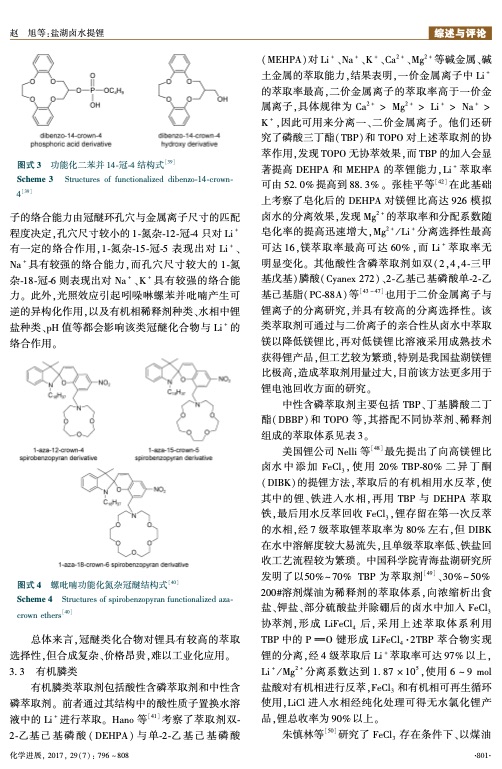
PDF Publication Title:
Text from PDF Page: 006
赵 旭等:盐湖卤水提锂 综述与评论 (MEHPA)对 Li + 、Na + 、K + 、Ca2 + 、Mg2 + 等碱金属、碱 土金属的萃取能力,结果表明,一价金属离子中 Li + 的萃取率最高,二价金属离子的萃取率高于一价金 属离子,具体规律为Ca2+ > Mg2+ > Li+ > Na+ > K + ,因此可用来分离一、二价金属离子。 他们还研 究了磷酸三丁酯(TBP)和 TOPO 对上述萃取剂的协 萃作用,发现 TOPO 无协萃效果,而 TBP 的加入会显 著提高 DEHPA 和 MEHPA 的萃锂能力,Li + 萃取率 可由 52 0% 提高到 88 3% 。 张桂平等[42] 在此基础 上考察了皂化后的 DEHPA 对镁锂比高达 926 模拟 卤水的分离效果,发现 Mg2 + 的萃取率和分配系数随 皂化率的提高迅速增大,Mg2 + / Li + 分离选择性最高 可达 16,镁萃取率最高可达 60% ,而 Li + 萃取率无 明显变化。 其他酸性含磷萃取剂如双(2,4,4⁃三甲 基戊基)膦酸(Cyanex 272)、2⁃乙基己基磷酸单⁃2⁃乙 基己基脂(PC⁃88A)等[43 ~ 47] 也用于二价金属离子与 锂离子的分离研究,并具有较高的分离选择性。 该 类萃取剂可通过与二价离子的亲合性从卤水中萃取 镁以降低镁锂比,再对低镁锂比溶液采用成熟技术 获得锂产品,但工艺较为繁琐,特别是我国盐湖镁锂 比极高,造成萃取剂用量过大,目前该方法更多用于 锂电池回收方面的研究。 中性含磷萃取剂主要包括 TBP、丁基膦酸二丁 酯(DBBP)和 TOPO 等,其搭配不同协萃剂、稀释剂 组成的萃取体系见表 3。 美国锂公司 Nelli 等[48] 最先提出了向高镁锂比 卤水中添加 FeCl3,使用 20% TBP⁃80% 二异丁酮 (DIBK)的提锂方法,萃取后的有机相用水反萃,使 其中的锂、铁进入水相,再用 TBP 与 DEHPA 萃取 铁,最后用水反萃回收 FeCl3 ,锂存留在第一次反萃 的水相,经 7 级萃取锂萃取率为 80% 左右,但 DIBK 在水中溶解度较大易流失,且单级萃取率低、铁盐回 收工艺流程较为繁琐。 中国科学院青海盐湖研究所 发明了以50%~70% TBP为萃取剂[49]、30%~50% 200#溶剂煤油为稀释剂的萃取体系,向浓缩析出食 盐、钾盐、部分硫酸盐并除硼后的卤水中加入 FeCl3 协萃剂,形成 LiFeCl4 后,采用上述萃取体系利用 TBP 中的 P O 键形成 LiFeCl4·2TBP 萃合物实现 锂的分离,经 4 级萃取后 Li + 萃取率可达 97% 以上, Li+ /Mg2+ 分离系数达到187 ×105,使用6 ~9 mol 盐酸对有机相进行反萃,FeCl3 和有机相可再生循环 使用,LiCl 进入水相经纯化处理可得无水氯化锂产 品,锂总收率为 90% 以上。 朱慎林等[50] 研究了 FeCl3 存在条件下、以煤油 ·8 0 1· 图式 3 Scheme 3 Structures of functionalized dibenzo⁃14⁃crown⁃ 功能化二苯并 14⁃冠⁃4 结构式[39] 4[39] 子的络合能力由冠醚环孔穴与金属离子尺寸的匹配 程度决定,孔穴尺寸较小的 1⁃氮杂⁃12⁃冠⁃4 只对 Li + 有一定的络合作用,1⁃氮杂⁃15⁃冠⁃5 表现出对 Li + 、 Na + 具有较强的络合能力,而孔穴尺寸较大的 1⁃氮 杂⁃18⁃冠⁃6 则表现出对 Na + 、K + 具有较强的络合能 力。 此外,光照效应引起吲哚啉螺苯并吡喃产生可 逆的异构化作用,以及有机相稀释剂种类、水相中锂 盐种类、pH 值等都会影响该类冠醚化合物与 Li + 的 络合作用。 图式 4 Scheme 4 Structures of spirobenzopyran functionalized aza⁃ crown ethers[40] 总体来言,冠醚类化合物对锂具有较高的萃取 选择性,但合成复杂、价格昂贵,难以工业化应用。 3 3 有机膦类 有机膦类萃取剂包括酸性含磷萃取剂和中性含 磷萃取剂。 前者通过其结构中的酸性质子置换水溶 液中的 Li + 进行萃取。 Hano 等[41] 考察了萃取剂双⁃ 2⁃乙基己基磷酸(DEHPA)与单⁃2⁃乙基己基磷酸 化学进展, 2017, 29(7): 796 ~808 螺吡喃功能化氮杂冠醚结构式[40]PDF Image | Extraction of Lithium from Salt Lake Brine

PDF Search Title:
Extraction of Lithium from Salt Lake BrineOriginal File Name Searched:
Extraction of Lithium from Salt Lake Brine.pdfDIY PDF Search: Google It | Yahoo | Bing
Product and Development Focus for Infinity Turbine
ORC Waste Heat Turbine and ORC System Build Plans: All turbine plans are $10,000 each. This allows you to build a system and then consider licensing for production after you have completed and tested a unit.Redox Flow Battery Technology: With the advent of the new USA tax credits for producing and selling batteries ($35/kW) we are focussing on a simple flow battery using shipping containers as the modular electrolyte storage units with tax credits up to $140,000 per system. Our main focus is on the salt battery. This battery can be used for both thermal and electrical storage applications. We call it the Cogeneration Battery or Cogen Battery. One project is converting salt (brine) based water conditioners to simultaneously produce power. In addition, there are many opportunities to extract Lithium from brine (salt lakes, groundwater, and producer water).Salt water or brine are huge sources for lithium. Most of the worlds lithium is acquired from a brine source. It's even in seawater in a low concentration. Brine is also a byproduct of huge powerplants, which can now use that as an electrolyte and a huge flow battery (which allows storage at the source).We welcome any business and equipment inquiries, as well as licensing our turbines for manufacturing.| CONTACT TEL: 608-238-6001 Email: greg@infinityturbine.com | RSS | AMP |